Cyanidin-3-O-sambubioside-5-O-glucoside chloride
Inquire / Order:
manager@chemfaces.com
Technical Inquiries:
service@chemfaces.com
Tel:
+86-27-84237783
Fax:
+86-27-84254680
Address:
1 Building, No. 83, CheCheng Rd., Wuhan Economic and Technological Development Zone, Wuhan, Hubei 430056, PRC
Providing storage is as stated on the product vial and the vial is kept tightly sealed, the product can be stored for up to
24 months(2-8C).
Wherever possible, you should prepare and use solutions on the same day. However, if you need to make up stock solutions in advance, we recommend that you store the solution as aliquots in tightly sealed vials at -20C. Generally, these will be useable for up to two weeks. Before use, and prior to opening the vial we recommend that you allow your product to equilibrate to room temperature for at least 1 hour.
Need more advice on solubility, usage and handling? Please email to: service@chemfaces.com
The packaging of the product may have turned upside down during transportation, resulting in the natural compounds adhering to the neck or cap of the vial. take the vial out of its packaging and gently shake to let the compounds fall to the bottom of the vial. for liquid products, centrifuge at 200-500 RPM to gather the liquid at the bottom of the vial. try to avoid loss or contamination during handling.
Key Engineering Materials2022, 931(47-53).
Mol Med Rep.2014, 9(5):1653-9
Life Sci.2022, 311(Pt A):121157.
Anim Cells Syst (Seoul).2024, 28(1):381-391.
Preprints2022, 202211.0388.v1.
Evid Based Complement Alternat Med.2021, 8855980.
Pharmacological Reports2020, 1-9
Phytomedicine.2019, 56:48-56
Phytomedicine.2024, 122:155065.
Drug Dev Ind Pharm.2024, 50(11):938-951.
Related and Featured Products
Acta horticulturae, 2015, 1061(1061):79-86.
Examination of anthocyanin content of some elderberry cultivars grown in Hungary.[Reference:
WebLink]
Profiling and quantitative analysis of anthocyanins in five elderberry (Sambucus nigra L.) varieties, namely ‘Haschberg’, ‘Samocco’, ‘Samyl’, ‘Samident’ and ‘Sampo’, were performed in six different maturity stages from two consecutive years (2012 and 2013) and from two growing areas in Hungary.
Cyanidin-3-O-sambubioside-5-O-glucoside(Cyanidin-3-O-sambubioside-5-O-glucoside chloride), cyanidin-3-O-sambubioside and cyanidin-3-O-glucoside were found and identified by HPLC-Q/TOF-MS as major anthocyanins and were quantified by HPLC-UV/Vis. In optimum maturity stage, ‘Samocco’ showed the highest anthocyanin content with an average of 1237 mg per 100 g dry weight in both growing areas and vintages. The dominant anthocyanin component of Samocco variety was cyanidin-3-O-sambubioside, which is according to literature more stable against technology processing than cyanidin-3-O-glucoside found in the other four investigated elderberry varieties in the highest concentration.
CONCLUSIONS:
'Samocco' had higher levels of total anthocyanins compared with most other cultivars at the two locations. Anthocyanin content was influenced by change of pH value and by heat treatment. After heat treatment, the highest anthocyanin concentration was observed at pH 3.5 with 'Haschberg', and at pH 3.0 with 'Samocco'. Total anthocyanin content was decreased 7% by heat treatment with 'Haschberg' and by 25% with 'Samocco' at the original pH value of 4.0.



